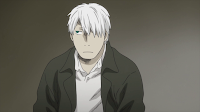This episode of Mushishi told a story of a man whose memories and physical being merged with a supernatural tree. The visual narrative sets up the fusion between man and tree with the use of color, tone and space.
 |  |  |
These wide shots of Kanta blend him with the color and tone of the woods as if he’s almost part of it. Kanta’s clothing share the same brown color and moderately grey tone that dominate his surroundings. The limited color and tonal separation between Kanta and the woods served as visual foreshadowing of his eventual transformation.
Another thing to note is the use of shafts of light as leading lines. Even though Kanta blends with the environment the leading lines keep the audience’s attention on him
 |  |
 |  |
In the scene leading up to Kanta’s fusion with the tree, regression in spatial depth were used in the wide shots to reflect his transformation. The first two wide shots use deep space composition to emulate a three dimensional world. The first accomplishes deep space by having Kanta moving in the z-axis (away from the camera) and the second shot does it differently by using a high camera angle that creates perspective lines (tree stump). As the scene approaches his transformation the sense of depth decreases as evident by the last two shots. These shots have limited spatial depth; strong depth cues that are perspective lines and z-axis movement are gone. Frontal planes (background, mid-ground and foreground) become the main but weaker depth cues. By limiting depth the spatial separation between the tree stump and Kanta decreases and helps create a visual build up of his transformation.

























































